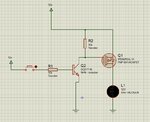Pat-UK
Newbie level 4

I have searched and cant seem to find the solution,
This design has always worked fine for low power outputs, but this seems to be destroying Mosfets on higher loads
I am using it to light a 55w halogen, if you turn it off and on slowly, then this is fine, but flash it a few times and the Mosfet goes short and starts cooking itself.
Unfortunatly as this is in a vehicle, it has to be Highside and has to be switched with a high signal, so am using P channel 50a Mosfets IPD50P04L **broken link removed** gate held high with 10k resistor, I am using a NPN transistor to switch the Mosfet on.
I know its a simple circuit, but cant seem to see why the halogen lamps keep making the magic smoke out of the Mosfets any help or add ons would be great.
Thanks